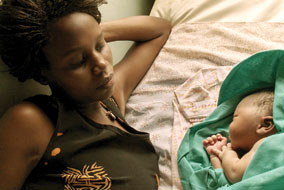
Mother Irene and baby, the first patients attended by UBC midwifery student Aisia Salo UBC Reports | Vol. 52 | No. 9 | Sep. 12, 2006
Midwives Without Borders
In the midwifery unit, Ward 14, where we have been working so far, there are about 20–30 births a day. The facilities are very basic. Only low-risk women can deliver here, so if they have complications or have had more than five babies, we don’t see them. About four or five midwives are on staff at any one time. Women come in alone and get assessed (have the abdomen palpated, fetal heart auscultated, and history taken) and then are sent home or to the labour area. This consists of one large room with bare beds.
The women are required to purchase supplies to bring with them: four pairs sterile gloves, two pieces of plastic to cover the bed, a roll of cotton wool (in place of sponges and pads), a razor blade to cut the cord, two syringes for oxytocin, and a cloth to dry and wrap the baby. These cost about $2 or so.
The monitoring in labour consists of vaginal exams every four hours or so, as at home, and once in awhile (maybe once or twice during labour) they use a metal Pinard horn to listen to the baby. There is one blood pressure cuff, which doesn’t seem to get used, and I don’t think they have a thermometer, nor do they take the maternal pulse. The oxygen, suction, and autoclave are all in disrepair and don’t work. They do have bag-and-masks.
There are experienced midwives. When the women feel like pushing, they call for the midwife and move into the delivery room, which has two tables. They lay their piece of plastic out and climb up, and push out their babies. |
 |
 |
 |
From: Midwifery students Aisia Salo and Chloe Dayman
Hospitals in Kampala and Masaka, Uganda
Third-year midwifery students Aisia Salo and Chloe Dayman, both of Victoria, B.C., spent six weeks attending births in Kampala and Masaka, Uganda, as part of a partnership between UBC and Makerere University, Uganda. They posted this note about their work on their blog
www.midwifeadventures.
blogspot.com. |
|
